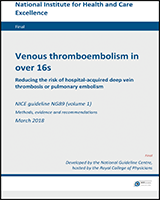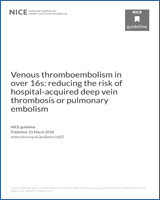NCBI Bookshelf. A service of the National Library of Medicine, National Institutes of Health.
National Guideline Centre (UK). Venous thromboembolism in over 16s: Reducing the risk of hospital-acquired deep vein thrombosis or pulmonary embolism. London: National Institute for Health and Care Excellence (NICE); 2018 Mar. (NICE Guideline, No. 89.)
December 2019: In recommendation 1.3.5 the British Standards for anti-embolism hosiery were updated because BS 6612 and BS 7672 have been withdrawn. August 2019: Recommendation 1.12.11 (1.5.30 in this document) was amended to clarify when anti-embolism stockings can be used for VTE prophylaxis for people with spinal injury.

Venous thromboembolism in over 16s: Reducing the risk of hospital-acquired deep vein thrombosis or pulmonary embolism.
Show details6.1. Introduction
After admission or a procedure at hospital a person’s medical condition will usually change. As a consequence of this change their risk of VTE and bleeding may also change. The last version of the guideline (CG92)124 recommended patients were reassessed every 24 hours. This update reviewed the evidence for the effectiveness of reassessment of VTE and bleeding risk to establish if this time point was appropriate for some or all patients.
6.2. Reassessment of risk for hospital admissions
6.2.1. Review question: How effective is reassessment of people who are admitted to hospital?
For full details see review protocol in appendix C.
Table 54
PICO characteristics of review question.
6.2.2. Clinical evidence
No relevant clinical studies comparing derived and validated risk tool with no risk tool for risk reassessment were identified in people who are admitted to hospital. See the study selection flow chart in appendix E and excluded studies list in appendix N.
6.2.3. Economic evidence
Published literature
No relevant health economic studies were identified.
See also the health economic study selection flow chart in appendix F.
6.2.4. Evidence statements
Clinical
No relevant clinical studies were identified.
Economic
No relevant economic evaluations were identified.
6.3. Reassessment of risk for day procedures
6.3.1. Review question: How effective is reassessment of people who are having day procedures at hospital?
For full details see review protocol in appendix C.
Table 55
PICO characteristics of review question.
6.3.2. Clinical evidence
No relevant clinical studies comparing derived and validated risk tool with no risk tool for risk reassessment were identified in people who are having day procedures at hospital. See the study selection flow chart in appendix E and excluded studies list in appendix N.
6.3.3. Economic evidence
Published literature
No relevant health economic studies were identified.
See also the health economic study selection flow chart in appendix F.
6.3.4. Evidence statements
Clinical
No relevant clinical studies were identified.
Economic
No relevant economic evaluations were identified.
6.4. Recommendations and link to evidence
| Recommendations |
|
| Research recommendation | None |
| Relative values of different outcomes |
The committee considered all-cause mortality (duration of study), VTE (symptomatic or asymptomatic) (duration of study), DVT (symptomatic or asymptomatic) (duration of study), pulmonary embolism (duration of study), fatal pulmonary embolism (duration of study), major bleeding (duration of study), and quality of life (validated scores) (duration of study) as critical outcomes. Fatal bleeding (duration of study), Heparin-induced thrombocytopenia (duration of study), clinically relevant non-major bleeding (duration of study), hospital length of stay (duration of study), unplanned readmission (duration of study) and haemorrhagic stroke (duration of study) were considered important outcomes. Please see section 4.4.3 in the methods chapter for further detail explaining prioritisation of the critical outcomes. |
| Quality of the clinical evidence | No clinical evidence was identified. |
| Trade-off between clinical benefits and harms |
The committee acknowledged the importance of re-assessing VTE and bleeding risk to guide prophylaxis provision or stopping decisions, which in turn would optimise their use. No evidence was found for the effectiveness of any VTE risk tool specifically for reassessment, and the committee did not consider that there was enough evidence for the accuracy or clinical effectiveness of any particular VTE or bleeding risk assessment tool from the reviews covering initial risk assessment to make a specific recommendation. Therefore the committee made a consensus recommendation that the VTE and bleeding risk for people admitted to hospital and those having day procedures should be reassessed at the point of senior review or if their clinical condition changes. The committee considered that undertaking the reassessment at the point of senior review or more frequently if there is a change in clinical condition would allow tailoring the need and the frequency of re-assessment to the individual clinical condition and optimise outcomes. The committee acknowledged that individuals undergoing day procedures attend the hospital for a short period of time and in the majority of cases are ambulant. Hence, reassessment would only be required if their clinical condition is likely to change. |
| Trade-off between net clinical effects and costs | No relevant economic studies were identified. The committee noted that the only resource that would be required for re-assessment is staff time; which would be minimal (approximately 10 minutes of a junior doctor’s time). The committee also noted that current practice is for re-assessment to be undertaken within 24 hours, which requires staff time, without evidence of cost-effectiveness. Hence the committee considered that it is not possible to mandate 24 hours as the time of review. Reassessment at the time of senior review was considered to be the most convenient and least resource intensive option as the reassessment would be done as part of a scheduled review. |
| Other considerations | None. |
- Reassessment of VTE and bleeding risk - Venous thromboembolism in over 16sReassessment of VTE and bleeding risk - Venous thromboembolism in over 16s
Your browsing activity is empty.
Activity recording is turned off.
See more...
